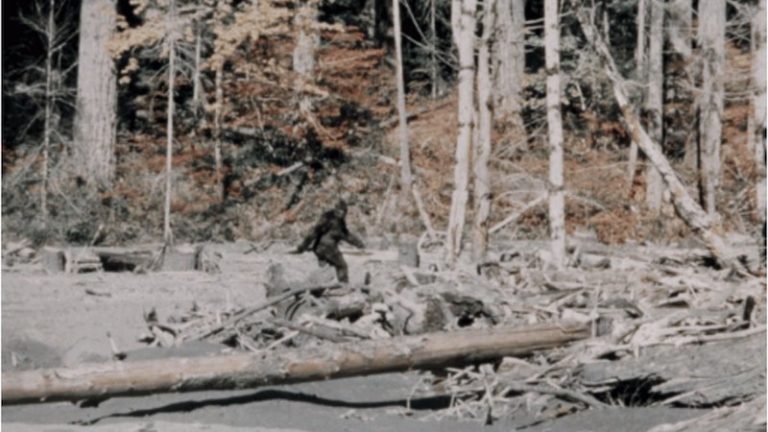
CRYPTOZOOLOGY CREATURES PROVEN REAL
Paradoxically, this is an actual science b*ased on rumor and hearsay, a legitimate discipline dedicated to proving the stuff of local legends and cultural myths to be true. This might be easy to dismiss if it weren’t for the large and growing catalog of cryptozoology creatures proven real.
THE PONGO
One of the most famous examples was known as the Pongo. In African folklore, according to The Cryptid Zoo, “the Pongo was a wild man of the jungle. Looking like a cross between a human and a monkey, he was a violent creature with magical powers” and a penchant for shape-shifting and an appetite for human flesh.
In 1847, the world was shocked by the announcement that the Pongo truly exists. Of course we now know that gorillas are vegetarians, gentle giants who neither capture, consume nor reproduce with humans. Nonetheless, their long-standing cultural association with such terrifying qualities survives in their very name, as “gorilla” is derived from the Arabic word for “ghoul.”
THE COELACANTH
Another success story concerns the Coelacanth (SEEL-uh-kanth) — a prehistoric fish thought to be extinct for 65 million years. That is, until 1938, when this strange “living fossil fish” showed up in a South African fish market.
http://www.newanimal.org/coelacanth.htm) The Cryptid Zoo tells us that “After being identified as a coelacanth and stuffed as a taxidermic specimen to preserve it, doubts were expressed about whether it was genuine. Scientists brought out all the arguments that they typically use to explain away cryptids, including that it was a misidentified normal animal… it was accused of being a common grouper, even though the remains did not resemble that fish. A second coelacanth was not captured until 1952.”
Since then, many live coelacanths have been captured and two subspecies have been identified, with the potential for more to come. Thus, despite deeply-seeded initial skepticism, the persistent existence of this prehistoric fish is now indisputable scientific fact.

According to the International Society of Cryptozoology, the coelacanth is considered a cryptid even though the fossil record proved its previous existence because “what makes an animal of interest to cryptology is that it is unexpected.”
The coelacanth is also significant in that it’s unique anatomical structures may demonstrate one link in the evolutionary chain that led animals out of the sea and onto land.
These are but two of the many stories out there of animals whose contemporary existence was purely speculative but later, through diligence and luck, was proven to be as real as the common squirrel.
For more such examples, The Cryptid Zoo has an extensive archive of information about various cryptids from around the world.
Want to be a Cryptozoologist?
A skilled cryptozoologist has mastered a wide range of disciplines, including but by no means limited to physical anthropology, mythology, linguistics, archaeology and history. Given the range and depth of research required to be a successful cryptozoologist, it’s no surprise that there are several Ph.D programs focused on the science.
One example is the Institute of m*etaphysical Humanistic Science (IMHS), an online program where “students will learn about… taxonomy and classification, research techniques, conducting field investigations, equipment, and working with other researchers. Evidence analysis is also covered, equipping students to analyze photos, videos, and other items that might assist in scientifically describing a reported animal. As an alternative, students may choose to specialize in “Hominology,” a branch of Cryptozoology focused on the study of primates or hominids such as Bigfoot, as opposed to all types of cryptids.”
However, an online degree is only worth the energy you personally apply to your studies. If you’ve got a true passion for cryptozoology, you must be first and foremost self-taught and self-motivated.
A great place to start your research is by studying myths, legends and folklore from your geographical area of interest.
Are you planning a trip to a place with excellent cryptozoological potentials? Or are you curious about what might be found lurking in the woods just beyond your backyard?
START YOUR OWN RESEARCH
Either way, Theresa Bane’s “Encyclopedia of Beasts and Monsters in Myth, Legend and Folklore” is a valuable resource. As the author writes in the preface, she believes this volume “to be unique in its completeness and in the breadth of its sources. I was determined to include every possible creature, leaving no culture, religion or time period untouched.”
For further inspiration, turn to George Noory’s Beyond Belief episode titled “The CryptoHunter with John Rhodes,” wherein they explore Rhodes obsession with seeking out the 85% of unknown creatures that currently share our planet.
For even more esoteric theories and applications, I recommend Max Igan’s ebook “Earth’s Forbidden History” wherein he discusses “Out-of-Place Parts” (OOPARTS), like a swiss watch discovered inside a piece of coal) as well as significant evidence that dinosaurs and humans may have at one time coexisted.
There are countless more extraordinary examples where concrete evidence points towards the living existence of creatures otherwise unthinkable. The hope is that the small sampling presented here will serve as inspiration for further inquiry.
In closing, we return to Borges waxing poetic about dragons. He writes, “We do not know what the dragon means, just as we do not know the meaning of the universe, but there is something about the dragon that is congenial to man’s imagination, thus the dragon arises in many latitudes and ages. It is, one might say, a necessary monster…”
How many monsters are still out there waiting to be found? Why are certain myths and mythological animals so pervasive throughout time and space? Are these creatures simply necessary aspects of our imagination? Or are they really real?
WHAT TO BRING WHEN SEARCHING FOR CRYPTOZOOLOGY CREATURES
The only way to find out is for yourself. Therefore, if you are going out in search of cryptids, be it in your backyard, a national park or in a foreign land, here are some items that will be of benefit to your hunt: